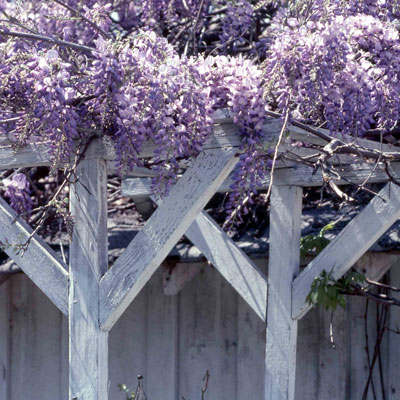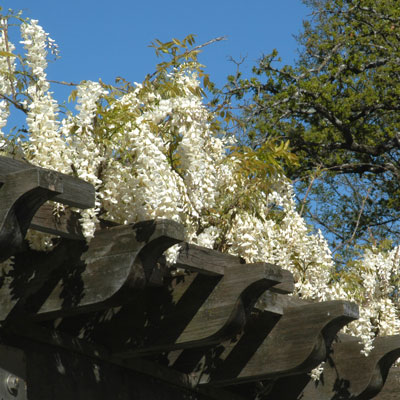Question of the Week – Number 2: March 28, 2019
“Why won’t my wisteria bloom?”
Those spiral notebooks I mentioned elsewhere – the ones I’ve kept by my microphone as I’ve broadcast for 42 years so I could keep record of all the questions gardeners ask… This is the most-asked question of all time when the subject is vines.

When they’re happy, wisterias bloom profusely. Their clusters are fragrant and glorious.
There are four possible reasons that wisterias fail to bloom. Unfortunately, they often overlap enough that it’s difficult to pin the bloom failure specifically on one of them.
• Wisterias need sun. Preferably full sun, dawn ‘til dusk. Once you give them more than a couple of hours of shade daily in summer, their flowering will decline.

This wisteria has been growing on its rustic old support for many years. Obviously it’s happy there.
• You must not prune wisterias in winter. They set their flower buds in the fall, and winter pruning will remove most or all of them. That also goes for climbing roses, Carolina jessamine, wisteria, azaleas, forsythia and other spring-blooming plants. All of these plants should be pruned immediately after they finish flowering. Or, if they fail to bloom, after when they should have flowered.

White-flowering wisteria is a stunning sight in its garden each spring.
• If you give wisterias nitrogen from mid-summer on, you’re likely to get strongly vegetative growth (at the expense of flower bud production). That most commonly happens when we grow wisterias in or near turfgrass, and when we apply the important fall feeding of a high-nitrogen or all-nitrogen fertilizer to our lawns in September or early October.
• Some contend that the non-blooming wisterias have been propagated from plants that have that genetic predisposition not to bloom. However, others of us ask why anyone would be saving that sort of a failed plant and trying to start new plants from it.
Here is a way that may work to trick one into bloom…
Try root-pruning your wisteria in early September. After a deep watering or heavy rain (if you’re lucky enough to get one), use a sharpshooter spade to cut a slit 10 or 12 inches deep and 15 inches out from the trunk.
You won’t be removing any soil – just severing the roots. Your hope would be that the shock of that root-pruning would throw the plant into a “survival-of-the-species” reproductive (blooming) mode. It’s worth a try, and it often does work.
